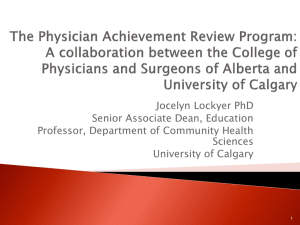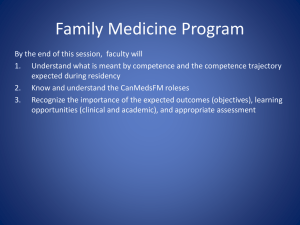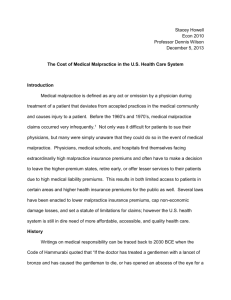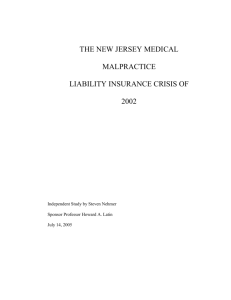Medical Liability - Emergency Medicine Residents Association
advertisement
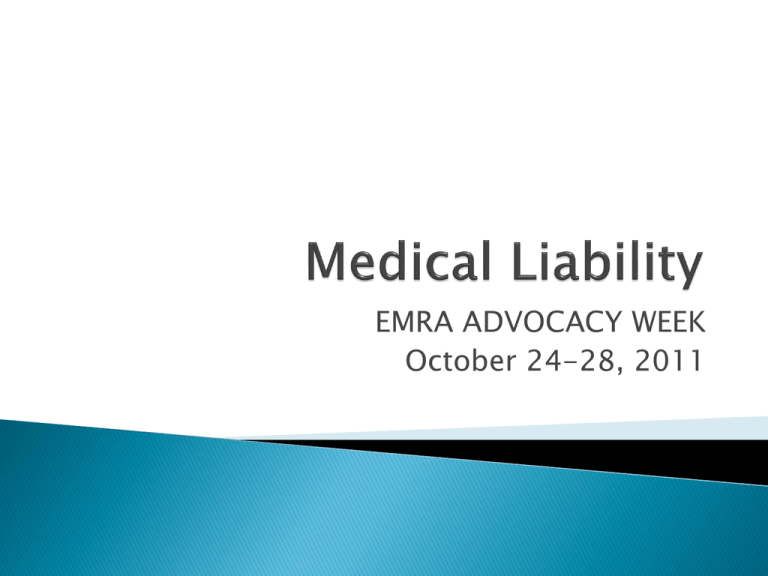
EMRA ADVOCACY WEEK October 24-28, 2011 There are four elements to a malpractice case: ◦ ◦ ◦ ◦ Duty Breach of Duty Injury Damage Each Element must be satisfied in order for the Plaintiff to win a case A duty is owed: a legal duty exists whenever a hospital or health care provider undertakes care or treatment of a patient. ◦ Under EMTALA Emergency Physicians have a duty to evaluate and stabilize all pts that come to the ED ◦ Other physicians may choose not to treat a pt and then do not owe a duty to the pt A duty is breached: the provider fails to conform to the relevant standard of care. ◦ The standard of care is proved by expert testimony ◦ 40% of states still follow the locality rule ◦ 60% of states follow the national standard of the profession A doctor must exercise the reasonable degree of learning and skill ordinarily possessed by physicians and surgeons in the locality where the doctor practices This allows for greater leeway for physicians practicing in rural areas that might not have access to consult expertise and other medical knowledge A physician has a duty to use the degree of care and skill that is expected of a reasonably competent practitioner in the same class to which he or she belongs, acting in the same or similar circumstances ◦ If an area lacks facilities or specialized expertise, the patient should be advised of where to seek the facilities The breach must cause an injury: The breach of duty must be a proximate cause of the injury. ◦ MD orders Gabapentin on the wrong pt. Pt then has MI. Must prove that the gabapentin was a cause of the MI Damages: Without damages (losses which may be physical or emotional), there is no basis for a claim, regardless of whether the medical provider was negligent. ◦ If a patient is mistakenly given another patient’s anti-hypertensive medication but only has no or only a slight drop in blood pressure that does not result the need for intervention or extending the hospital stay there are no likely damages Data taken from the AMA’s 2007-2008 Physician Practice Information Survey ◦ 5,825 physicians from 42 specialties 42% of physicians had a claim filed against them during their career ◦ 95 Claims were filed for every 100 physicians 20% were sued 2+ times 5% had a claim in the last 12 months Kane, C. Policy Research Perspectives: Medical Liability Claim Frequency: A 2007-2008 Snapshot of physicians.” (Chicago, IL: American Medical Association 2010). The older the physician the more likely they are to have been sued ◦ Under 40 : 15.3% ◦ 40-54: 45.3% ◦ 55+: 60.5% Kane, C. Policy Research Perspectives: Medical Liability Claim Frequency: A 2007-2008 Snapshot of physicians.” (Chicago, IL: American Medical Association 2010). Who is sued the most: 1. 2. 3. 4. 5. OB/GYN General Surgeons Surgical Sub –Specialties Radiology Emergency Medicine Men are sued more then women ◦ Men: 47.5% ◦ Women: 23.9% But men are concentrated in specialties with the highest levels of claim incidence ◦ 23.8 % of men are surgeons or OB/GYNs 14.8% women are surgeons or OB/GYNs ◦ 25.1% of women are pediatricians or psychiatrists 13.2% of men are pediatricians or psychiatrists 33% of Men are 55+ and only 15% of women 65% of claims were dropped, dismissed or withdrawn 25.7 % were settled 4.5% were decided by alternative dispute mechanism 5% resolved by trial * With defendant winning 90% of the time Physician Insurers Association of America. Claim Trend Analysis 2009 Edition. (Rockville, MD: Physicians Insurers Association of America, 2009) Average defense costs per claim was $40,649 ◦ $22, 163 for dropped, dismissed, withdrawn claims ◦ Over $100K for tried cases Median Indemnity payments ◦ $200k for settled claims ◦ $375k for tried claims * Physician Insurers Association of America. Claim Trend Analysis 2009 Edition. (Rockville, MD: Physicians Insurers Association of America, 2009) 1452 closed claims reviewed by trained physicians for 5 liability insurers showed: ◦ 3% of closed claims show no injury had occurred ◦ 37% of closed claims there had been no error ◦ 27% of closed claims involving errors were uncompensated ◦ 27% of closed claims with no errors were compensated * Studder, DM. et al. “Claims Errors, and Compensation Payments in Medical Malpractice Litigation.” New England Journal of Medicine 354 (May 11, 2006): 2024-2033. Less than 15% of patient who suffered from negligence filed a claim Negligence occurred in only slightly over 15% of filed claims Weiler et al. A measure of Malpractice: Medical Injury, Malpractice Litigation, and Patient Compensation (Cambridge, MA: Harvard University Press 1993) Brown et al looked at medical liability claims from 1985-2007 provided by Physicians Insurers Assoc of America (PIAA) ◦ PIAA is a trade association whose medical liability carriers collectively insure 60% of practicing physicians in the US 11,529 claims identified Largest source of error – ◦ errors in diagnosis (37%) ◦ improper performance of procedure (17%) ◦ no error identifiable (18%) AMI (5%) Fractures(6%) Appendicitis (2%) Interestingly… The ED provider was the primary defendant in only 19% of claims ◦ This fact plays into the difficulty of getting specialty coverage in the ED 70% of cases closed with NO payment made to claimant 23% paid out via settlement 7% of cases resolved via verdict (85% of those in favor of the physician) Selbst et al reviewed of malpractice cases involving pediatrics… PIAA (at that time covering 25% of physicians) queried for claims that originated in EDs and urgent care centers that involved kids from 1985-2000. 2283 closed claims reviewed 96% of cases from EDs 4% from urgent care centers 29% of the cases involved the ED physician, 19% the pediatrician 66% of physicians sued had a previous claim Most common diagnoses – meningitis, appendicitis, fracture, testicular torsion. Cases settled 93% of the time Payment only made in 30% Trial in only 6.9% If trial – verdict for physician 80% of the time ◦ 33 States have enacted some kind tort reform ◦ Most have caps on non-economic damages at about 250,000 dollars ◦ Non-economic damages do not included damages for: Future medical expenses Loss of wages Wheel Chairs and other medical supplies Nursing home/home health aids Of the 33 states with tort reform 31 have caps Of those 33: ◦ 12 Supreme Court cases determined that caps are constitutional ◦ 16 have not had Supreme Court Cases ◦ 2 are pending litigation ◦ 1 state found the caps unconstitutional ◦ 1 state amended their constitution to make caps constitutional There are 19 states that do not have caps Of those 19 states: ◦ 6 states have Supreme Court decisions stating caps are unconstitutional ◦ 4 states have constitutions that specifically state caps are unconstitutional ◦ 9 states have not addressed the issue Patients are told by supporting medical malpractice caps and giving up some of their legal rights in return they will get better access to doctors and the cost of healthcare will be decreased But consider this… * A 2004 report by the Congressional Budget Office also pegged medical malpractice costs at 2 percent of U.S. health spending and “even significant reductions” would do little to reduce the growth of health-care expenses.* CBO, available at http://www.cbo.gov/ftpdocs/49xx/doc4968/01-08- MedicalMalpractice.pdf ◦ JAMA article reports states with caps have a 2.4% increase in physician supply* *Kessler, D; et al. Impact of Malpractice Reforms on the Supply of Physician Services, JAMA. 2005;293:2618-2625. available at http://jama.amaassn.org/cgi/content/full/293/21/2618 Comprehensive liability reform including caps on non economic damages passed by Texas legislature and voters Resultant increase in emergency physicians in the state= improved access “Effects of Texas Liability Reform 2003-2009” http://www.acep.org/content.aspx?id=45168 Decreased malpractice premiums Remittitur: ◦ allows the judge to throw out jury verdicts that are too high Administrative proceedings: ◦ are substituted for common law damages (jury trials), such as in workers compensation proceedings, are constitutional, ◦ therefore the creation of an administrative court to hear medical liability cases may also be constitutional Sliding Scale Damages: ◦ Damages would be based on the severity of the injury ◦ Would allow more severely injured patients greater compensation and would ensure that patients with injuries of similar severity get the same compensation ◦ The National Association of Insurance Commissioners already has an injury severity scale that could be applied to medical liability. Affordable Care Act allotted 20 million dollars for research focused on alternative medical liability reform such as: ◦ Mitigation ◦ Panels to screen cases ◦ Creating reward funds ◦ Regulation of Malpractice Insurance Premiums






